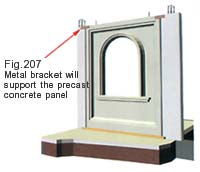
Performance under Vertical
Loads
The precast wall panels are designed as load bearing wall system.
Depending on the height of the building, the thickness of the wall
panels can be varied. The wall is reinforced with BRC mesh at the
center both for the vertical load support as well as during the
lifting/installation stage. The wall is stiffened with enlargement
to 200mm thick at the edges and reinforced using high tensile reinforcement.
These top stiffened edges act as transfer beams for window or door
openings while the side stiffened edges allow stronger support during
lifting stage.
Integrity or Strength of Joints
 The
thickening of the edge of the wall panel allows for a reasonable
size of vertical recess to be formed on either side of the wall
panel to form a core for the construction joint of 125 x 100 oval
shape cavity when two adjoining panels or panel and column are assembled
together and this provides a space of tolerance for easy installation.
This large cavity can be filled with chipping concrete well vibrated
to form a strong wet joint. This wet joint also acts as a cast-in-situ
stiffener (once a vertical steel bar has been inserted and concrete
has been poured into the core) and bonds the panel to the column.
As such, it can prevent the ingress of water effectively. This joint
is able to transfer lateral load by shear action of the concrete
infill to the adjacent columns. This can be further improved by
adding non-shrinkage cement-plaster to finish the construction joint
of all external walls. For horizontal construction joints, rawl
bolts are inserted into the floor beam for levelling control prior
to pouring the expandite concrete and installation of the precast
concrete wall panel. Two groove lines along the bottom face of the
panel will provide better bonding and also prevents ingress of water
effectively. The
thickening of the edge of the wall panel allows for a reasonable
size of vertical recess to be formed on either side of the wall
panel to form a core for the construction joint of 125 x 100 oval
shape cavity when two adjoining panels or panel and column are assembled
together and this provides a space of tolerance for easy installation.
This large cavity can be filled with chipping concrete well vibrated
to form a strong wet joint. This wet joint also acts as a cast-in-situ
stiffener (once a vertical steel bar has been inserted and concrete
has been poured into the core) and bonds the panel to the column.
As such, it can prevent the ingress of water effectively. This joint
is able to transfer lateral load by shear action of the concrete
infill to the adjacent columns. This can be further improved by
adding non-shrinkage cement-plaster to finish the construction joint
of all external walls. For horizontal construction joints, rawl
bolts are inserted into the floor beam for levelling control prior
to pouring the expandite concrete and installation of the precast
concrete wall panel. Two groove lines along the bottom face of the
panel will provide better bonding and also prevents ingress of water
effectively.
Performance under Lateral Loads
The lateral loads are transferred from the wall panels to the adjacent
columns via shear key action in the concrete infill between the
panel and column. These lateral loads are then resisted by the cast-in-situ
columns, which are adequately reinforced.
Durability and Design Life
As the system consists of cast-in-situ columns, precast concrete
wall panels and half-slab floor panels that are finished with in-situ
topping and BRC, the durability is essentially governed by performance
of concrete. With the Grade 35 concrete used, the panels are very
durable and the design life will exceed the 50 years required by
the code of practice.
Fire Safety and Toxicity
The grade 35 concrete precast panels provide very good fire resistance.
The concrete is non-combustible material and hence does not give
out any toxic gas
Environmentally Friendly
The construction site is practically free of messy clutter and debris
while being more environmentally friendly at the same time.
|









